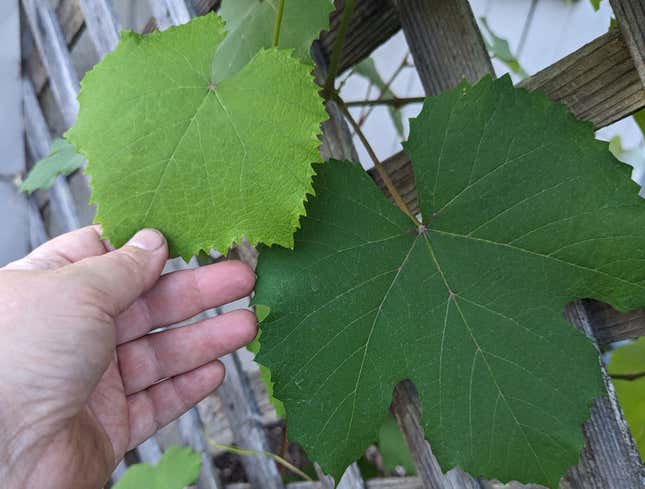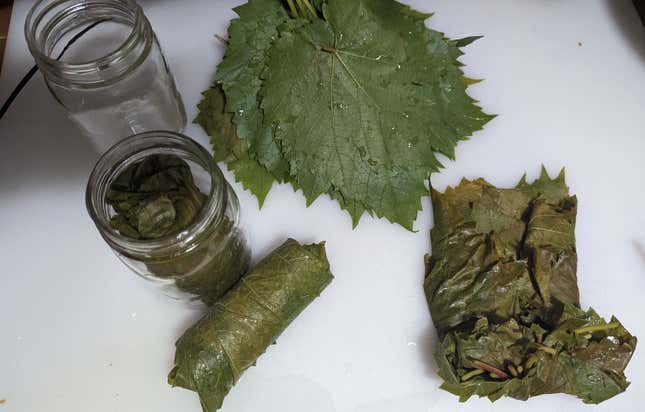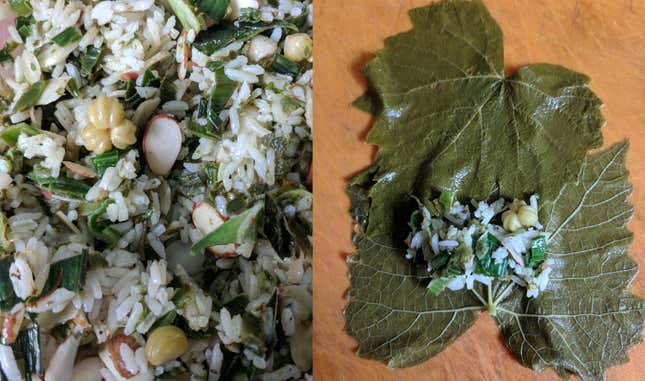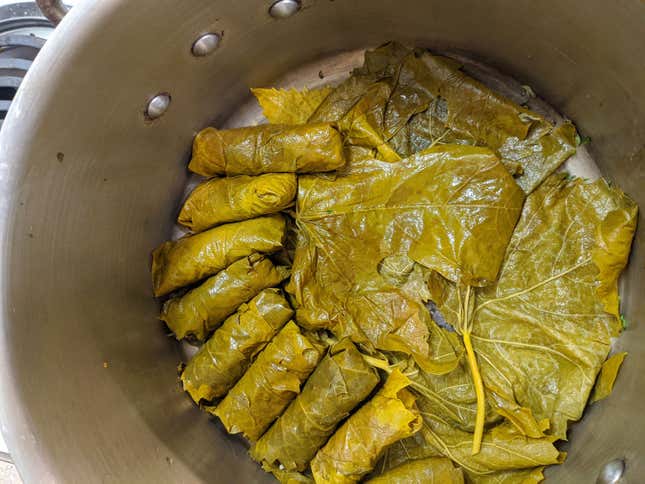Consider the underestimated grape leaf. Each year, grape vines are cut back, and turn brown and woody, then emerge vivaciously fresh with green shoots in the late spring. These vines grow aggressively each year, taking over any structure they can. The grapes are the focus, but the leaves shouldn’t be overlooked. They are versatile and delicious in ways you aren’t thinking of, and are the foundation of some smashing summer treats.
How to find grape leaves for free
Table of Contents
You can walk yourself into most grocery stores and buy grape leaves, in a jar, ready to go. A jar ranges from $4-$12, and you only get fifty or so leaves. I’ve got no complaints about the taste, but the cost usually prohibits people from using them more. If you can lay your hands on real grapevines, then an endless supply of leaves is yours for the taking, for free.
Most of us don’t grow grapevines (although, I would lobby that just one vine is a great addition for reasons I’ll outline below), but they’re not hard to locate, because: wine. That’s right, somewhere near you is a vineyard. I know this because I’ve been to some very shitty places and there’s still, somehow, a vineyard nearby. Also, people grow grapes pretty much everywhere, and often they are overwhelmed by the fruit and the vines, and are happy to find others to help. They have no use for those leaves, so they’re unlikely to object to someone taking some.
Find them the way I recommend finding most things: through local gardening groups on Facebook, Discord or Reddit. Don’t bother looking for posts about grape leaves, no one posts about them, you’ll need to post saying that you’re looking for someone who’ll let you grab some grape leaves, and that you’ll only take a few from each vine, and it doesn’t hurt the grapes at all (we’re going to leave enough to keep those grapes covered). As a note, you want to be sure these grape vines aren’t sprayed.

Once you locate some grape vines, you’re going to look for leaves using two criteria: You want them to be large enough to wrap something with, and you want them to be bright green instead of army green. The darker, thicker leaves don’t make for good eating, so we’ll stick to the bright green younger ones. Usually, this is leaves 3-5 on a vine.
To pick them, you just pluck them off, stem and all, taking care to not hurt the vine. You want to ensure any baby grapes have coverage from a leaf, so you shouldn’t overpick. Take as many as they’ll let you (they store well), throw them in a bucket and head home.
How to Preserve Grape Leaves
In particular, the sought after “pint-and-a-half” ball jars are perfect for saving grape leaves, and they’re the same size as the grape leaf jars you buy in the store. Take all your leaves, face them the same way, then put them in a bucket with water, and give them a good swish to clean them.
Set an 8-quart pot on the stove and fill it with water. Add 8 tablespoons of canning or other non-iodized salt to the water and stir to dissolve. Allow it to come to a boil, then a simmer. Divide your leaves into stacks of fifty or so leaves. Take a pair of tongs, and grasp the leaves at one end, and dip them into the water, and hold them there, with the tongs, under water for 12-15 seconds. They’ll turn dark green quickly. Bring them out of the water, shake them off, and lay them on your cutting board. Repeat this with all the leaves.

Once they’re cool enough to work with, you’re going to take your stack, fold the bottom up, then fold both sides in and tightly roll the leaves into a cigar shape. Use a piece of twine to tie the cigar so it holds its shape, then it goes into the jar. The jar should hold a few cigars worth, so stuff them in there.
Now, add ¼ teaspoon of citric acid to the jar, and ladle in the water from the stockpot, leaving a half-inch of headroom at the top. Put a clean lid on, then process it in a water bath for ten minutes. This means you get a large stock pot that will hold the jars in one level, lay a towel in the bottom of the pot, and fill the pot with hot water. Place the jars in, packed tightly but all on one level, and ensure the water covers them by a few inches, and then slowly bring the water to a boil, covered.
Once at a rolling boil, start the clock and let boil for ten minutes, then turn the stove off and let the pot come to room temperature, then remove the jars. As long as the lid has suctioned on thirty minutes after the jar has been removed, it has been safely processed and is shelf-stable. Each jar is worth at least $6-$8, and encourages you to make more with grape leaves over the year.
How to Use Grape Leaves
If you have access to raw grape leaves, they have a few uses. The tannic acid in them makes them a common addition to pickles. Like oak leaves, the tannins help keep your vegetables crispy through the pickling process. You simply add a leaf to the top or bottom of your jars and process them. It’s why it’s handy to have even a lone grape vine at your place.
You can also use fresh or brined grape leaves as a wrap around your cheeses, to add more flavor to them. Personally, once they’re brined, I love to wrap scallops with them and then grill them, or just wrap fresh mozzarella with them for a little extra oomph. They’re tender and soft, but the brininess is what really makes them magical.

But the main reason people buy grape leaves is to make dolma, or dolmades– stuffed grape leaves. These Turkish or Greek delights are the ideal for summer snacking or as lunchtime treat. They’re a phenomenal option for picnics or potlucks because they’re essentially finger food. Traditionally, you’d wrap the leaves around a rice mixture, then roll them into small cylinders, and it’s common for dolmades to come in vegetarian and meat options.
The vegetarian option, usually served cold, is a lemony rice with pine nuts and capers, served with a yogurt sauce for dipping. The less vegetarian version is lamb mixed with the rice, served hot, with a thick, tangy lemon sauce that’s similar to avgolemono. As a wrapper, the grape leaves add a sweet brininess, and if you choose the leaves right when picking them, aren’t stringy at all in texture. You bite right through them with ease.
But you can also break free of tradition and stuff them with any grain for a light, summery appetizer or snack. Roll leaves with cooked cous cous, pickled red onions, sliced almonds and feta, as pictured above, for a fresh take. This chickpea and bulgur recipe has just enough bite from the crunchy parsley to be really refreshing. The Turkish version of dolmas usually has tomatoes in it, and with the summer flush coming in, you can augment those with diced yellow squash and zucchini in the mix, and add a little extra spice from harissa.
About once a month I make more traditional lamb and beef dolmades, which I pack into the fridge for snacking on, but always end up eating obsessively for every meal until they’re gone. They make it worthwhile for me to drive once a year just outside town to visit someone I found in my gardening group, years ago, who grows a few kinds of grapes at his home, and lets me come out to pick leaves. It’s worth it for the free leaves, which make this usually expensive treat affordable, but also because it’s how I meet interesting people. Enjoy this recipe.
Amanda’s Stuffed Grape Leaves
- 100 grape leaves you canned yourself, or two jars of grape leaves from the supermarket
- ½ lb ground lamb
- ½ lb ground beef, 90% lean or more
- 1 large yellow onion
- 1 large clove of garlic
- 4 ounces of capers
- ½ cup of pine nuts (optional, you can exclude if they’re out of your price range or substitute with slivered almonds)
- 2 cups of uncooked long grain white rice
- 6 cups of stock (because lamb stock is impossible to find, I use a rich chicken stock)
- ¼ cup of lemon juice
- 1 tbsp cumin
- 1 tbsp oregano
- 1 tbsp Salt
- Pepper to taste
Peel the onion, quarter it and put it into your food processor with the peeled garlic and pulse it to make a paste. Add the onion, beef, lamb, rice, nuts and capers to a large bowl and combine thoroughly. Add the spices and the lemon juice and mix again.
Unpack your leaves, and lay them flat in a stack on your cutting board. Get a heavy bottomed stock pot out and put it next to you. Place a layer of grape leaves in the bottom of the pot, just enough to cover it.

Now, take one grape leaf, and lay it flat on a cutting board, with the stem facing you. Cut or pinch off the stem, and place a heaping tablespoon of the filling in the bottom third nearest you. Wrap the bottom of the leaf up and over the top, moving away from you. Now fold both the left and the right side of the leaf in, around the filling, and then gently roll the leaf away from you, around the filling.
Place the rolled leaf, seam side down, in the stockpot. Repeat with the other leaves, packing them in tightly, until the layer is full. Then start a new layer and continue until you run out of leaves.
Place a plate, just smaller than the pot itself, upside down on top of the dolmades. This should weigh them down. Now pour the stock over them, making sure they’re completely covered. Put the lid on the pot and slowly bring it to a boil over medium-high heat, then quickly reduce it to simmer. Simmer with the lid on for 45 minutes to an hour. You’ll know it’s done when the liquid is gone.
Transfer the dolmades one by one to a container to store in the fridge. When you’re ready to eat, you simply reheat them (they’re very microwavable) and either add a dash of salt and pepper, or make a lemon sauce.
Lemon sauce for Stuffed Grape Leaves
- 1 tbsp cornstarch
- 1/4 cup lemon juice
- 1 large egg
- 2 cups of rich chicken stock
- A handful of fresh chopped parsley or 1 tablespoon dried parsley flakes
Add the cornstarch to ½ cup of the stock and set aside. If you let it sit for a few minutes, the cornstarch will rehydrate and be easier to mix in. Meanwhile, put the rest of the stock in a pot on the stove, and add the lemon juice. Allow the pot to come to a boil, then reduce to a simmer. Use a fork to mix the cornstarch into the stock you set aside, making sure there are no lumps, and then add this to the pot, and mix in well.
In a separate bowl, crack the egg and whisk it really well. Grab a ladle, and while you are whisking the egg, slowly drizzle in a tablespoon or two of the hot stock mixture. It should not curdle the eggs if you’re whisking constantly, but will temper them. Repeat this process until you have a cup of the hot stock in the egg mixture. Add the egg mixture to the pot, and continue whisking the sauce. Allow it to cook at a simmer for 6-8 minutes, until it has thickened enough to coat a spoon. Then pour it over your dolmades, top with the parsley, and live your best life.
